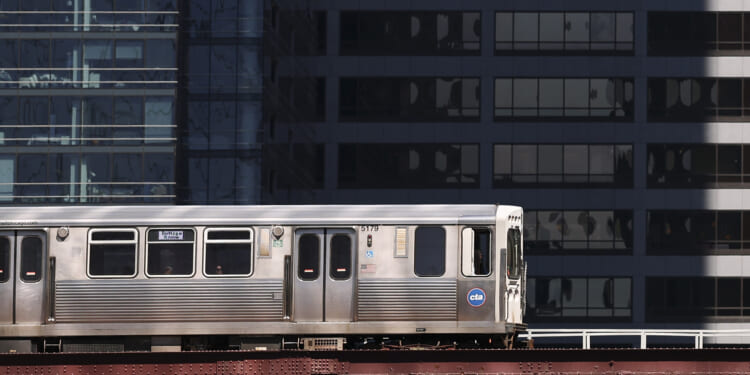Chicago Transit Authority ridership is still below pre-pandemic levels. Crime and a budget shortfall make matters worse, but there are cost-effective ways to make it safer.
U.S. Transportation Secretary Sean Duffy recently called out the Chicago Transit Authority and the Massachusetts Bay Transportation Authority, demanding that they take accountability for crime affecting both riders and transit workers. He wasn’t threatening to send in the National Guard. Instead, he asked these systems to produce their own credible plans to address public safety.
That demand could not be timelier. Illinois lawmakers are returning for veto session, and many are urging the state take action over the CTA’s looming budget deficit. Before the state steps in, Chicago must tackle this crisis decisively. Start by addressing the long-term structural costs but in the dramatic drop in ridership caused directly by safety fears.
As of 2023, CTA ridership was barely 60% of its pre-pandemic levels, with rail ridership down 46%. The farebox now covers only about one-fifth of operating expenses — a catastrophic imbalance for a system long dependent on rider fares. Once federal pandemic relief money runs out, the CTA will be left with two disastrous options: steep fare increases or service cuts.
Without a significant federal or state bailout — unlikely in today’s political climate — the only sustainable solution is to restore ridership. And that will not happen without restoring public safety.
A 2023 WBEZ survey found 45% of riders said they felt “somewhat unsafe” or “very unsafe” on buses and trains. Only 7% reported feeling “very safe.” This is not just a perception problem. CTA operators themselves echo these concerns, citing threats, harassment and crime that undermine morale and drive absenteeism. The inability to retain and recruit operators directly worsens service, creating delays and gaps that further discourage ridership.
The administrator Marc Molinaro of the Federal Transit Administration reported that in the first half of this year, over 2,200 crimes were reported on the CTA, including 642 batteries, 238 assaults, 259 robberies and 29 sex offenses. Last year’s Blue Line shooting left four dead, and violent crimes per passenger trip have more than tripled since 2015. According to police reports, riders now face a crime every three hours somewhere in the system.
How has city hall reacted? By cracking down on smokers. That’s not a public safety plan — it’s a punchline.
Today, only 135 Chicago Police Department officers are assigned to protect 79 stations, 146 platforms, and 335 trains. By comparison, New York City deploys over 1,000 New York Police Department transit officers. Private CTA security firms add about 300 unarmed guards and 50 dogs, but these workers are minimally trained, lack arrest power and are known by criminals to be ineffective deterrents. Meanwhile, the mayor’s personal security detail is on par with, if not larger than, the police contingent protecting millions of daily riders. The imbalance speaks volumes.
Chicago needs a properly resourced transit police force. This requires creating a specialized CPD Public Transit Unit under its own command. Illinois Policy Institute has estimated hiring a police officer for every train station could cost as little as $20 million annually.
Functional panic buttons and staffed security kiosks would guarantee rapid response to emergencies. Coordinated policing with Metra, Amtrak, Illinois State Police and local university police would expand law enforcement presence across the system. Providing “police transit passes” would encourage off-duty officers from other jurisdictions to ride and increase visibility.
Safety requires not just officers on the ground but laws that carry consequences. That means proactive enforcement of city ordinances. Chicago should pass a city nuisance ordinance imposing real penalties on those who disrupt public transit — whether through vandalism, harassment, assaults or threats against transit workers.
The CTA also faces serious structural issues beyond safety. Nearly half its workforce is composed of non-operator staff, with headcount growing 30% since COVID despite plummeting ridership. Streamlining administration and returning to pre-pandemic staffing ratios would save millions. Consolidation of CTA, Metra, Pace and the Regional Transit Authority should be considered to reduce redundancy and improve coordination.
The most alarming financial threat, however, is the ballooning Red Line extension project. Initially budgeted at $3.6 billion, costs have surged to $5.75 billion, at $1 billion per mile. Of that, the CTA is saddled with $3 billion in debt — a 747% increase over the $266 million initially projected. Without parallel investments in corridor economic development, the Red Line extension will not generate the fare revenue needed to sustain its operations. Chicago cannot paper over these crises with subsidies and bailouts.
Before providing additional state funding, Illinois lawmakers must ensure the CTA has a meaningful plan to restore ridership and public safety as well as fix its spending and governance issues. This could be the quickest, most cost-effective way to pull the CTA back from the brink and is the most direct path to stabilizing the system’s finances, protecting current riders, and attracting new ones.










